Helium-3 Aneutronic Fusion Energy
ex-iskon-pleme :: Društvo :: Znanost :: Na rubu znanosti
Page 1 of 1
 Helium-3 Aneutronic Fusion Energy
Helium-3 Aneutronic Fusion Energy
_________________
И показа ми чисту реку воде живота, бистру као кристал, која излажаше од престола Божијег и Јагњетовог.

Winter is coming-

Posts : 9181
2014-04-14
 Re: Helium-3 Aneutronic Fusion Energy
Re: Helium-3 Aneutronic Fusion Energy
ITER NEWSLINE -
27 FEB, 2017- Print
- Read the latest published articles
Last stages of assembly for behemoth tool
-Krista Dulon
Among the dozens of specially designed tools that will have a role to play in positioning and assembling ITER's giant machine components, two stand—literally—a head and shoulders above the others. As tall as a seven-storey building, made of hundreds of tonnes of steel, the sector sub-assembly tools will support charges of up to 1,200 tonnes during out-of-pit pre-assembly activities for the ITER vacuum vessel sectors. With factory assembly nearly finalized, Korea expects to deliver the first tool to the ITER site in June.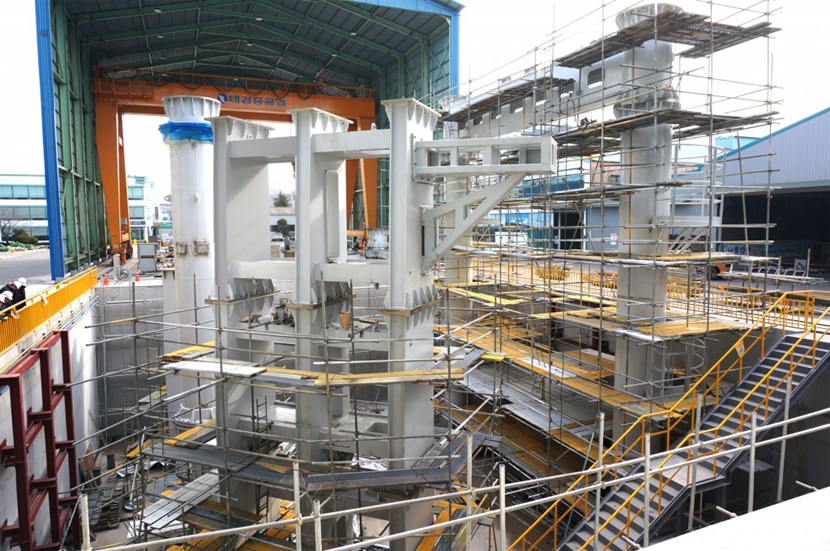
The first of two sector sub-assembly tools in its assembly pit at Taekyung Heavy Industries in Korea. The tool's inboard and outboard columns were machined in sections and bolted together; interior ribbing adds structural strength. All told, the tool is designed to support the weight of one vacuum vessel sector, two toroidal field coils and thermal shielding ... or 1,200 tonnes.
At Taekyung Heavy Industries (THI) in Changwon, South Korea, a special assembly area has been created for ITER's largest custom-designed tool. The base elements are nearly out of sight, installed in a pit dug eight metres into the ground. The towering columns are surrounded by scaffolding. Nearby, a sliding warehouse structure stands ready to protect the work zone in the case of inclement weather.
"At 22 metres tall and 860 tonnes, the sector sub-assembly tools are certainly the biggest of the ITER assembly tools that Korea will procure for ITER," says Hyung Yeol Yang, from ITER's Tokamak Assembly Section/Division. "But the challenge is not in their size, even if fabrication does require a huge milling machine, capable of machining components up to 30 metres in length. The challenge is in the function of the tool itself—supporting 440-tonne vacuum vessel sectors while two 310-tonne toroidal field coils are positioned and aligned to millimetre-level assembly tolerances."
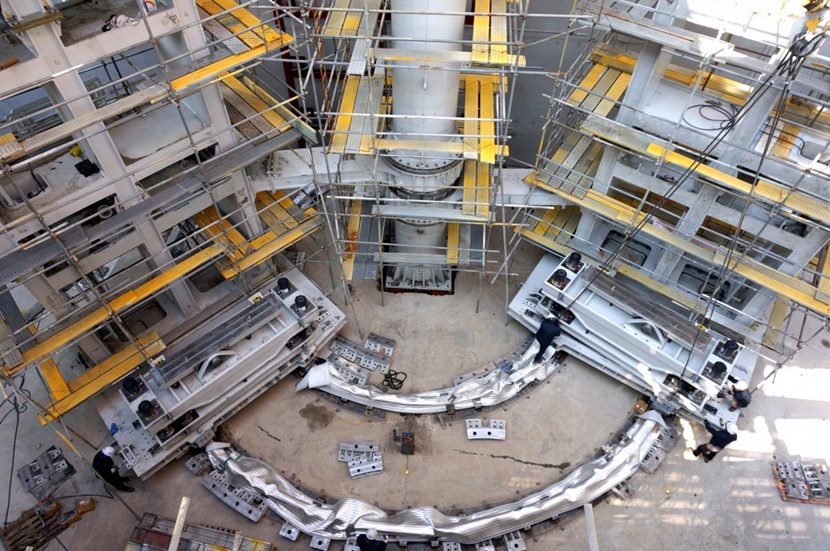
Precision hydraulics will drive the tool's lateral wings, which rotate to deliver the toroidal field coils to their installation fixtures on the 40° vacuum vessel sector, suspended in the centre. The different structural elements of the first tool have been manufactured and their in-factory assembly is 70% complete.
ITER's plasma chamber, or vacuum vessel, will be formed from nine wedge-shaped steel sectors that measure over 14 metres in height and weigh 440 tonnes. Each one will be shipped from manufacturing facilities in Europe and Korea on horizontal transport frames. Once delivered to the ITER Assembly Hall—and following vacuum tests and the installation of magnetic diagnostics—the 40° sectors will be moved to a vertical position, or "upended" in ITER parlance.
That's where the behemoth sector sub-assembly tools enter the scene. The tools are designed to suspend each sector from the top while vacuum vessel thermal shielding and a pair of toroidal field coils are installed.
The components to be installed are mounted on frames, which are in turn installed on rotating platforms, or "wings," of the sector sub-assembly tool. Hydraulic cylinders located at the base of the tools will urge the rotating platforms forward in the toroidal direction in a "push and clamp" motion. As they approach the suspended vacuum vessel sector, actuators on the rotating platforms will allow the components to positioned with the highest accuracy—just 1.5 mm for the toroidal field coils—and adjusted to six degrees of freedom*.
"The main structure, rotating frames and actuator system of these hydraulic-powered tools were all tested on a 1:5-scale mockup," reports Hyung Yeol. "This important qualification step led to improvements in the design, a final design review, and the green light for the start of manufacturing which got off to a start in March 2016."
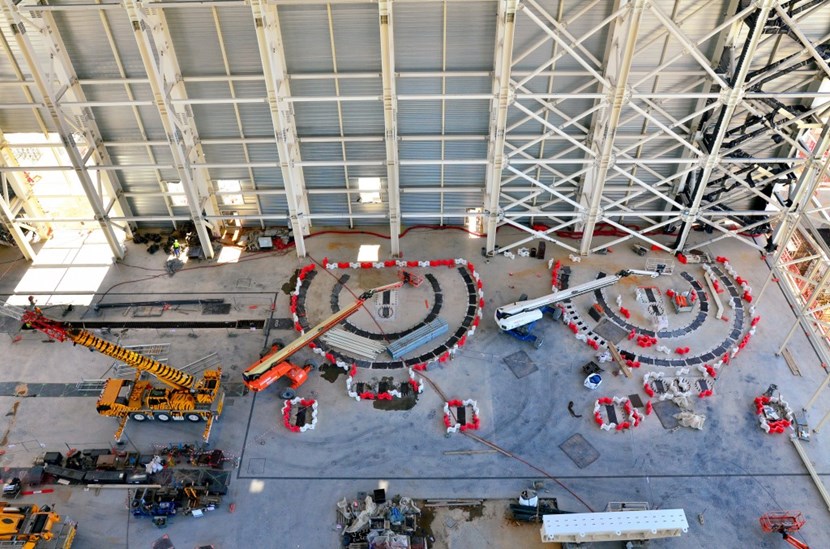
An area of the ITER Assembly Hall has been specially reinforced to receive the incredible weight of the sector sub-assembly tools (860 tonnes each) and the components they support (1,200 tonnes). Two identical tools will allow vacuum vessel pre-assembly work to proceed more quickly.
Today, the assembly of the structure of the first tool has progressed to 70 percent, the actuator system has been delivered for installation, and factory acceptance tests are planned to verify that the tool performs the required movements without jamming or malfunction and that the required alignment can be reached.
If all goes well, the tool will be disassembled and shipped in 54 packages to the ITER Organization before the end of June. Re-assembly activities on site and final site acceptance tests—including a load test of 310 tonnes—will be supervised by THI, with work mainly carried out by THI's local contractor CNIM (France).
Fabrication activities will begin on the second sector sub-assembly tool in Korea as soon as the first is shipped.
The Korean Domestic Agency is responsible for the design and fabrication of 43 assembly tools. For the sector sub-assembly tools, its main contractor SFA Engineering Corp has contracted with Taekyung Heavy Industries for the fabrication of all structures, sub-assembly and testing, and on-site installation. Precision hydraulic actuators are supplied by ENERPAC (Spain).
* Six degrees of freedom refers to adjustability along X, Y and Z axes (up and down, side to side, forward and backward) as well as in rotational directions relative to the axes (swivel, tilt, pivot).

Guest- Guest
 Re: Helium-3 Aneutronic Fusion Energy
Re: Helium-3 Aneutronic Fusion Energy
[size=50]China spends big on nuclear fusion as French plan falls behind[/size]
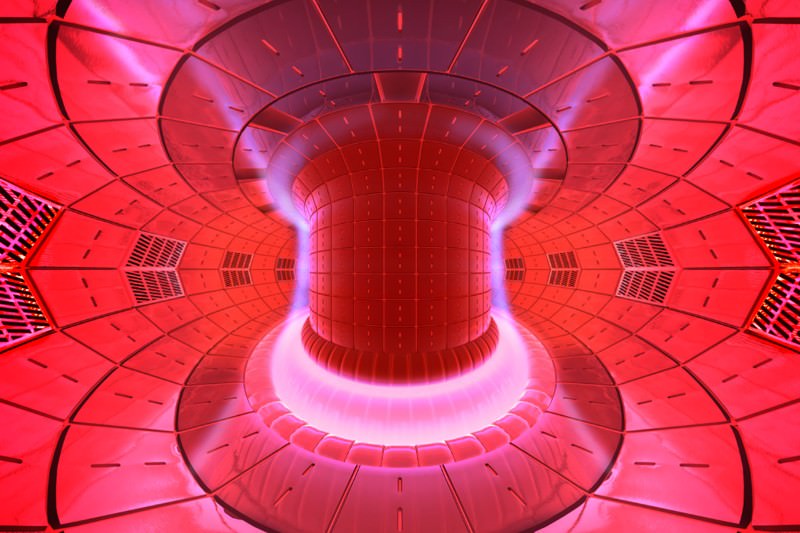
By Fred Pearce
China’s will be bigger and better (Image: David Parker/SPL)
The world’s largest nuclear fusion machine, currently being built in France, is unlikely to produce more energy than it consumes until the early 2030s, warned the UK’s head of fusion research this week. That is five years later than planned – by which time China could be ahead of everyone.
Nuclear fusion involves heating a plasma of hydrogen isotopes so that they fuse into helium, releasing a large amount of energy in the process. Many physicists see it as the holy grail for producing cheap zero-carbon energy. But initiating the fusion reactions requires temperatures 10 times as hot as the core of the sun. And decades of experiments have yet to produce self-sustaining fusion reactions – known as “burning plasma” – that generate the energy required to produce such temperatures.
[size]
The International Thermonuclear Experimental Reactor (ITER), a $20 billion machine being built in Cadarache, France, should get there. “We are confident that it will,” Steven Cowley, director of the Culham Centre for Fusion Energy in Oxfordshire, told the science and technology committee of the UK’s House of Lords on Tuesday. But it is taking time and money.
Only then will the international researchers, many of whom have been working together for decades, move on to building a new plant that could generate continuous power – the forerunner for what they hope will be commercial nuclear fusion by late in the century. “But the biggest investment now is in China,” says Cowley. China is a collaborator on ITER, along with the European Union, the US and others. But it is investing heavily in building its own reactor, the China Fusion Engineering Test Reactor, which will be bigger than ITER and may be finished by 2030, he said.
Cowley disclosed that some partners had discussed whether to continue collaboration with China or shut them out. “We decided to continue to collaborate.” Shutting China out “would only slow them down by a few months”, he told the Lords, who are investigating whether the UK government is getting value for money in its fusion investments. Fusion currently accounts for 14 per cent of UK government spending on energy research, Sharon Ellis of the Department for Business, Innovation and Skills told the committee.[/size]

By Fred Pearce
China’s will be bigger and better (Image: David Parker/SPL)
The world’s largest nuclear fusion machine, currently being built in France, is unlikely to produce more energy than it consumes until the early 2030s, warned the UK’s head of fusion research this week. That is five years later than planned – by which time China could be ahead of everyone.
Nuclear fusion involves heating a plasma of hydrogen isotopes so that they fuse into helium, releasing a large amount of energy in the process. Many physicists see it as the holy grail for producing cheap zero-carbon energy. But initiating the fusion reactions requires temperatures 10 times as hot as the core of the sun. And decades of experiments have yet to produce self-sustaining fusion reactions – known as “burning plasma” – that generate the energy required to produce such temperatures.
Ads by ZINC |
The International Thermonuclear Experimental Reactor (ITER), a $20 billion machine being built in Cadarache, France, should get there. “We are confident that it will,” Steven Cowley, director of the Culham Centre for Fusion Energy in Oxfordshire, told the science and technology committee of the UK’s House of Lords on Tuesday. But it is taking time and money.
Burning plasma
Constructing ITER has already cost three times as much as budgeted, and completion has slipped from 2016 to 2019, with the first plasma experiments the following year. Cowley told the committee: “ITER says 2020, but I believe the first plasma will be [generated] in 2025.” Burning plasma is unlikely before “the early 2030s”, he said. He likened the moment when burning plasma is achieved to the moment in the early 1940s when the first “critical” nuclear fission reactions were produced.Only then will the international researchers, many of whom have been working together for decades, move on to building a new plant that could generate continuous power – the forerunner for what they hope will be commercial nuclear fusion by late in the century. “But the biggest investment now is in China,” says Cowley. China is a collaborator on ITER, along with the European Union, the US and others. But it is investing heavily in building its own reactor, the China Fusion Engineering Test Reactor, which will be bigger than ITER and may be finished by 2030, he said.
Cowley disclosed that some partners had discussed whether to continue collaboration with China or shut them out. “We decided to continue to collaborate.” Shutting China out “would only slow them down by a few months”, he told the Lords, who are investigating whether the UK government is getting value for money in its fusion investments. Fusion currently accounts for 14 per cent of UK government spending on energy research, Sharon Ellis of the Department for Business, Innovation and Skills told the committee.[/size]

Guest- Guest
 Re: Helium-3 Aneutronic Fusion Energy
Re: Helium-3 Aneutronic Fusion Energy
[size=31]Britain Moving Ahead with Spherical Tokamak Fusion Reactor
April 29, 2017[/size]
Britain's newest fusion reactor being built by Oxfordshire-based Tokamak Energy has fired up its latest fusion reactor for the first time and aims to reach temperatures of 100m degrees Celsius next year, taking the world one step further towards generating electricity from the power of the stars.

Known as the ST40, the reactor represents the third of five stages in the company’s plan to deliver fusion energy to the grid by 2030. Controlled fusion requires temperatures in excess of 100m°C, but this has never been achieved by a privately funded company. To reach that goal, Tokamak Energy is focusing on compact, spherical Tokamak reactors, as it believes they are quicker to develop and offer the quickest route to commercial fusion power.
The heart of the Tokamak ST40 reactor - a super-hot cloud of electrically charged gas, or plasma - is expected to reach a temperature of 100 million centigrade next year. That is how hot it needs to be to trigger fusion, the joining together of atomic nuclei accompanied by an enormous release of energy. The reactor will provide clean energy to the UK's national grid by 2030, according to its creators Tokamak Energy.
The spherical tokamak is an offshoot of the conventional tokamak design. Proponents claim that it has a number of substantial practical advantages over these devices. For this reason the ST has generated considerable interest since the late 1980s. However, development remains effectively one generation behind traditional tokamak efforts like JET. Major experiments in the ST field include the pioneering START and MAST at Culham in the UK, the US's NSTX-U and Russian Globus-M.

The amount of fusion energy a Spherical Tokamak is capable of producing is a direct result of the number of fusion reactions taking place in its core. Scientists know that the larger the vessel, the larger the volume of the plasma ... and therefore the greater the potential for fusion energy.
The next steps in the ST40’s development will see the reactor’s magnetic coils commissioned and installed. These are crucial for containing the super-heated plasma and pushing towards fusion temperatures. By Autumn 2017, the company hopes to have produced a plasma temperature of 15m°C, with 100m°C reached at some point in 2018. Longer term, Tokamak Energy is aiming to deliver its first fusion electricity by 2025, with commercial power available via the grid five years later.
What is Fusion
Fusion is the energy source of the Sun and stars. In the tremendous heat and gravity at the core of these stellar bodies, hydrogen nuclei collide, fuse into heavier helium atoms and release tremendous amounts of energy in the process.
Twentieth-century fusion science identified the most efficient fusion reaction in the laboratory setting to be the reaction between two hydrogen isotopes, deuterium (D) and tritium (T). The DT fusion reaction produces the highest energy gain at the "lowest" temperatures.


Three conditions must be fulfilled to achieve fusion in a laboratory: very high temperature (on the order of 100,000,000° Celsius); sufficient plasma particle density (to increase the likelihood that collisions do occur); and sufficient confinement time (to hold the plasma, which has a propensity to expand, within a defined volume).
At extreme temperatures, electrons are separated from nuclei and a gas becomes a plasma—often referred to as the fourth state of matter. Fusion plasmas provide the environment in which light elements can fuse and yield energy.
In a Tokamak device, powerful magnetic fields are used to confine and control the plasma.
ITER (International Thermonuclear Experimental Reactor, also Latin for "way") is an international nuclear fusion research and engineering megaproject, which will be the world's largest magnetic confinement plasma physics experiment. It is an experimental tokamak nuclear fusion reactor that is being built next to the Cadarache facility in Saint-Paul-lès-Durance, which is in southern France.
The ITER project aims to make the long-awaited transition from experimental studies of plasma physics to full-scale electricity-producing fusion power stations. The ITER fusion reactor has been designed to produce 500 megawatts of output power for around twenty minutes while needing 50 megawatts to operate.[2] Thereby the machine aims to demonstrate the principle of producing more energy from the fusion process than is used to initiate it, something that has not yet been achieved in any fusion reactor.
http://www.nowscience.co.uk/single-post/2017/04/29/Britain-Moving-Ahead-with-Spherical-Tokamak-Fusion-Reactor
April 29, 2017[/size]
Britain's newest fusion reactor being built by Oxfordshire-based Tokamak Energy has fired up its latest fusion reactor for the first time and aims to reach temperatures of 100m degrees Celsius next year, taking the world one step further towards generating electricity from the power of the stars.

Known as the ST40, the reactor represents the third of five stages in the company’s plan to deliver fusion energy to the grid by 2030. Controlled fusion requires temperatures in excess of 100m°C, but this has never been achieved by a privately funded company. To reach that goal, Tokamak Energy is focusing on compact, spherical Tokamak reactors, as it believes they are quicker to develop and offer the quickest route to commercial fusion power.
Britains first commercial fusion reactor
The heart of the Tokamak ST40 reactor - a super-hot cloud of electrically charged gas, or plasma - is expected to reach a temperature of 100 million centigrade next year. That is how hot it needs to be to trigger fusion, the joining together of atomic nuclei accompanied by an enormous release of energy. The reactor will provide clean energy to the UK's national grid by 2030, according to its creators Tokamak Energy.
“Today is an important day for fusion energy development in the UK, and the world,” said Dr David Kingham, CEO of Tokamak Energy. “We are unveiling the first world-class controlled fusion device to have been designed, built and operated by a private venture. The ST40 is a machine that will show fusion temperatures – 100 million degrees – are possible in compact, cost-effective reactors. This will allow fusion power to be achieved in years, not decades.”
The spherical tokamak is an offshoot of the conventional tokamak design. Proponents claim that it has a number of substantial practical advantages over these devices. For this reason the ST has generated considerable interest since the late 1980s. However, development remains effectively one generation behind traditional tokamak efforts like JET. Major experiments in the ST field include the pioneering START and MAST at Culham in the UK, the US's NSTX-U and Russian Globus-M.

The amount of fusion energy a Spherical Tokamak is capable of producing is a direct result of the number of fusion reactions taking place in its core. Scientists know that the larger the vessel, the larger the volume of the plasma ... and therefore the greater the potential for fusion energy.
The next steps in the ST40’s development will see the reactor’s magnetic coils commissioned and installed. These are crucial for containing the super-heated plasma and pushing towards fusion temperatures. By Autumn 2017, the company hopes to have produced a plasma temperature of 15m°C, with 100m°C reached at some point in 2018. Longer term, Tokamak Energy is aiming to deliver its first fusion electricity by 2025, with commercial power available via the grid five years later.
What is Fusion
Fusion is the energy source of the Sun and stars. In the tremendous heat and gravity at the core of these stellar bodies, hydrogen nuclei collide, fuse into heavier helium atoms and release tremendous amounts of energy in the process.
Twentieth-century fusion science identified the most efficient fusion reaction in the laboratory setting to be the reaction between two hydrogen isotopes, deuterium (D) and tritium (T). The DT fusion reaction produces the highest energy gain at the "lowest" temperatures.


Three conditions must be fulfilled to achieve fusion in a laboratory: very high temperature (on the order of 100,000,000° Celsius); sufficient plasma particle density (to increase the likelihood that collisions do occur); and sufficient confinement time (to hold the plasma, which has a propensity to expand, within a defined volume).
At extreme temperatures, electrons are separated from nuclei and a gas becomes a plasma—often referred to as the fourth state of matter. Fusion plasmas provide the environment in which light elements can fuse and yield energy.
In a Tokamak device, powerful magnetic fields are used to confine and control the plasma.
ITER (International Thermonuclear Experimental Reactor, also Latin for "way") is an international nuclear fusion research and engineering megaproject, which will be the world's largest magnetic confinement plasma physics experiment. It is an experimental tokamak nuclear fusion reactor that is being built next to the Cadarache facility in Saint-Paul-lès-Durance, which is in southern France.
The ITER project aims to make the long-awaited transition from experimental studies of plasma physics to full-scale electricity-producing fusion power stations. The ITER fusion reactor has been designed to produce 500 megawatts of output power for around twenty minutes while needing 50 megawatts to operate.[2] Thereby the machine aims to demonstrate the principle of producing more energy from the fusion process than is used to initiate it, something that has not yet been achieved in any fusion reactor.
Take a tour of the ITER facility
http://www.nowscience.co.uk/single-post/2017/04/29/Britain-Moving-Ahead-with-Spherical-Tokamak-Fusion-Reactor

My Brother Billo- Posts : 2237
2017-04-17
 Re: Helium-3 Aneutronic Fusion Energy
Re: Helium-3 Aneutronic Fusion Energy
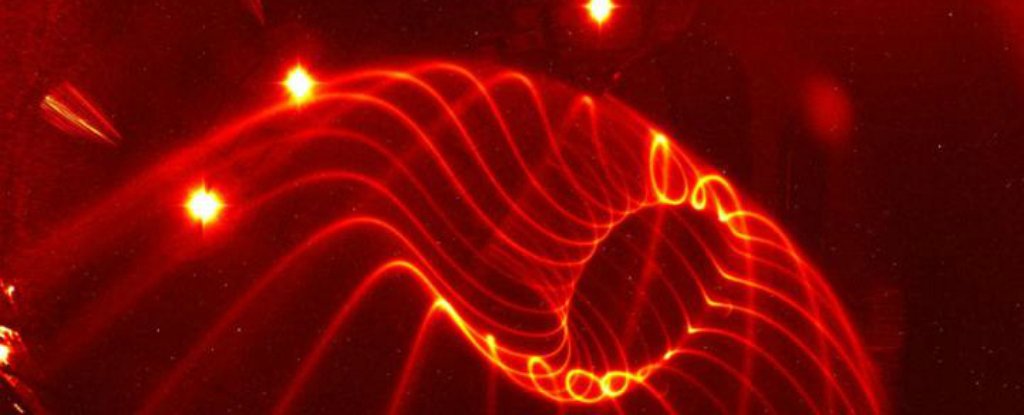
Nature Communications
Tests Confirm That Germany's Massive Nuclear Fusion Machine Really Works
Harnessing the power of the Sun.
FIONA MACDONALD
6 DEC 2016
At the end of 2015, Germany switched on a new type of massive nuclear fusion reactor for the first time, and it was successfully able to contain a scorching hot blob of helium plasma.
But since then, there's been a big question - is the device working the way it's supposed to? That's pretty crucial when you're talking about a machine that could potentially maintain controlled nuclear fusion reactions one day, and thankfully, the answer is yes.
A team of researchers from the US and Germany have now confirmed that the Wendelstein 7-X (W 7-X) stellerator is producing the super-strong, twisty, 3D magnetic fields that its design predicted, with "unprecedented accuracy". The researchers found an error rate less than one in 100,000.
"To our knowledge, this is an unprecedented accuracy, both in terms of the as-built engineering of a fusion device, as well as in the measurement of magnetic topology," the researchers write in Nature Communications.
That might not sound exciting, but it's crucial, because that magnetic field is the only thing that will trap hot balls of plasma long enough for nuclear fusion to occur.
Nuclear fusion is one of the most promising sources of clean energy out there - with little more than salt water, it offers limitless energy using the same reaction that powers our Sun.
Unlike nuclear fission, which is achieved by our current nuclear plants, and involves splitting the nucleus of an atom into smaller neutrons and nuclei, nuclear fusion generates huge amounts of energy when atoms are fused together at incredibly high temperatures. And it produces no radioactive waste or other byproducts.
Based on the longevity of our Sun, nuclear fusion also has the potential to supply humanity with energy for as long as we need it - if we can figure out how to harness the reaction, that is.
And that's a pretty big 'if', because scientists have been working on the problem for more than 60 years, and we're still a fair way off our goal.
The main challenge is that, in order to achieve controlled nuclear fusion, we have to actually recreate conditions inside the Sun. That means building a machine that's capable of producing and controlling a 100-million-degree-Celsius (180 million degree Fahrenheit) ball of plasma gas.
As you can imagine, that's easier said than done. But there are several nuclear fusion reactor designs in operation around the world right now that are trying their best, and the W 7-X is one of the most promising attemps.
Instead of trying to control plasma with just a 2D magnetic field, which is the approach used by the more common tokamak reactors, the stellerator works by generating twisted, 3D magnetic fields.
This allows stellerators to control plasma without the need for any electrical current - which tokamaks rely on - and as a result, it makes stellerators more stable, because they can keep going even if the internal current is interrupted.
Well, that was the idea of its design, at least.
Despite the fact that the machine successfully controlled helium plasma in December 2015, and then the more challenging hydrogen plasma in February 2016, no one had shown that the magnetic field was actually working as it should be.
To measure it, a team of researchers from the US Department of Energy and the Max Planck Institute of Plasma Physics in Germany sent an electron beam along the magnetic field lines in the reactor.
Using a fluorescent rod, they swept through those lines and created light in the shape of the fields. The result, which you can see in the image above, shows the exact type of twisted magnetic fields that it was supposed to make.
"We've confirmed that the magnetic cage that we've built works as designed," said one of the lead researchers, Sam Lazerson from the US Department of Energy's Princeton Plasma Physics Laboratory.
Despite this success, W 7-X isn't actually intended to generate electricity from nuclear fusion - it's simply a proof of concept to show that it could work.
In 2019, the reactor will begin to use deuterium instead of hydrogen to produce actual fusion reactions inside the machine, but it won't be capable of generating more energy than it current requires to run.
That's something that the next-generation of stellerators will hopefully overcome. "The task has just started," explain the researchers in a press release.
It's not something that will happen tomorrow, but it's an incredibly exciting time for nuclear fusion, with W 7-X officially competing with France's ITER tokamak reactor - both of which have been able to trap plasma for long enough for fusion to occur.
The real question now is, which of these machines will be the first to bring us efficient power from nuclear fusion? We can't wait to find out.
The research has been published in Nature Communications.

My Brother Billo- Posts : 2237
2017-04-17
ex-iskon-pleme :: Društvo :: Znanost :: Na rubu znanosti
Page 1 of 1
Permissions in this forum:
You cannot reply to topics in this forum
 Events
Events Latest images
Latest images
 by Winter is coming Wed 9 Mar - 13:43
by Winter is coming Wed 9 Mar - 13:43